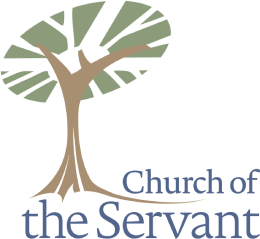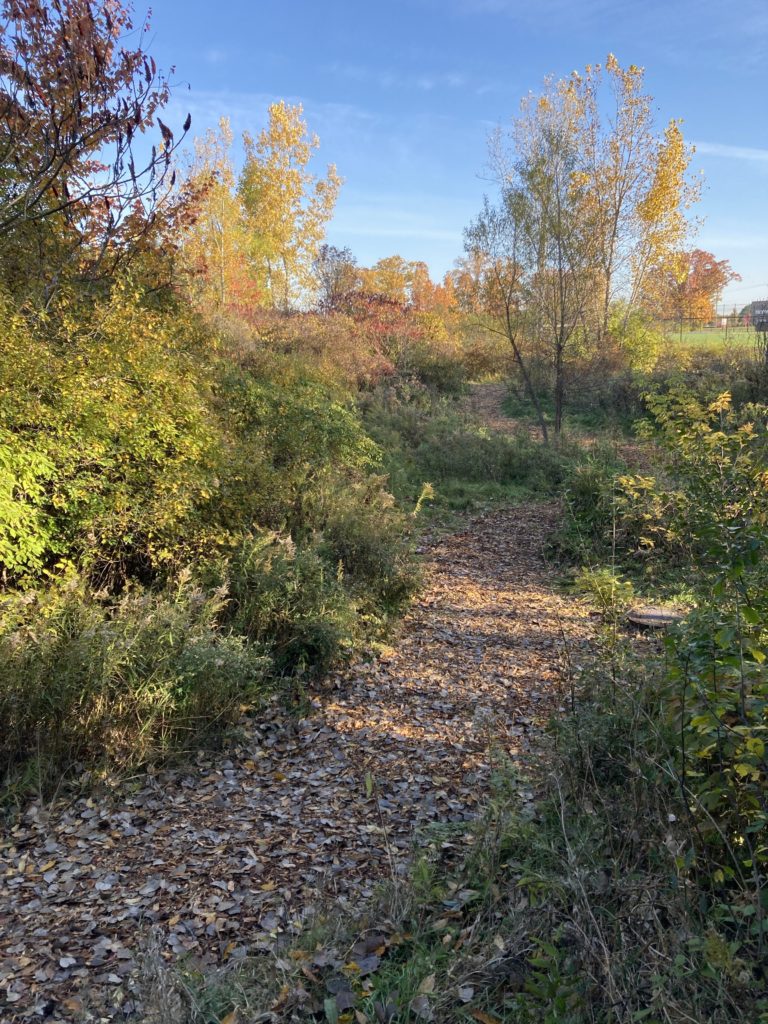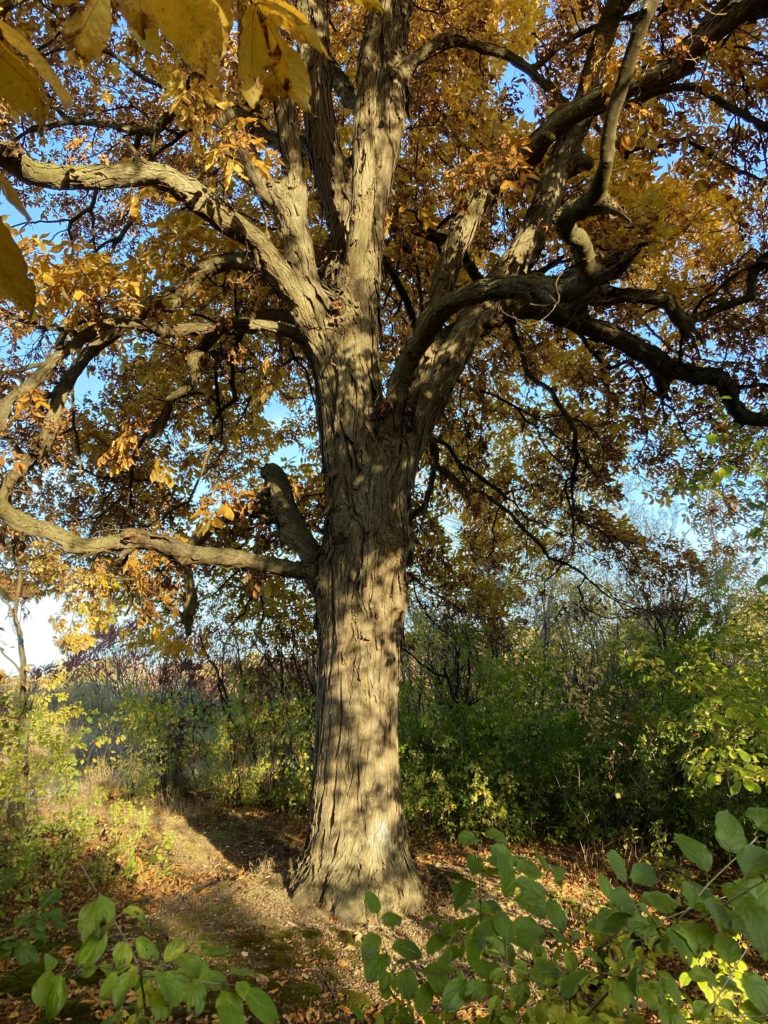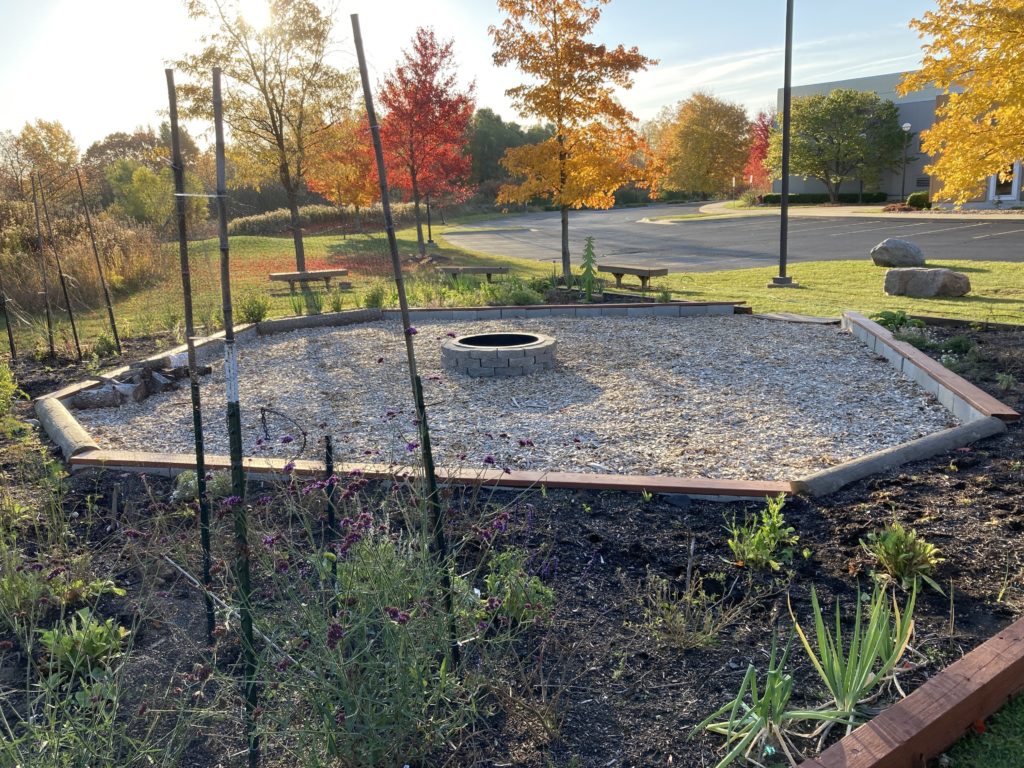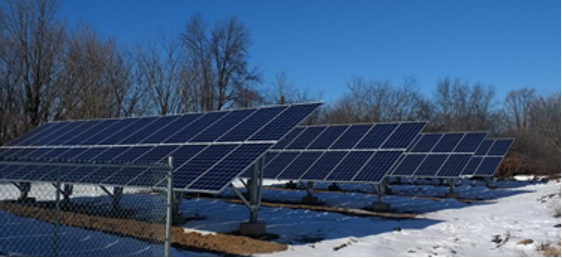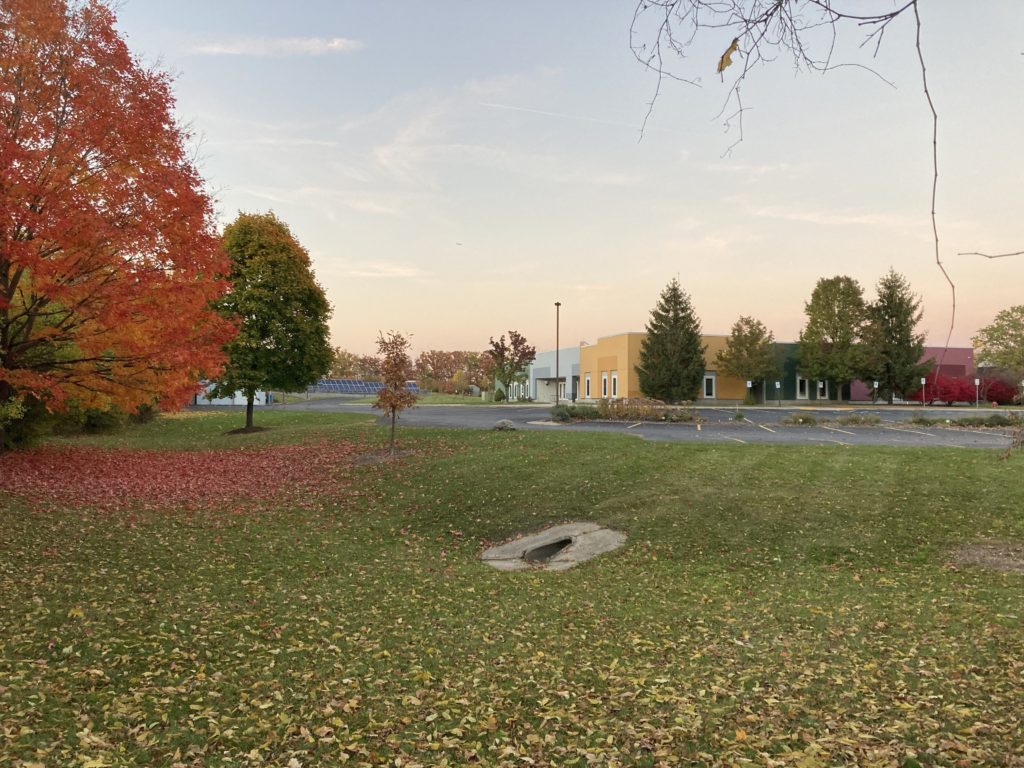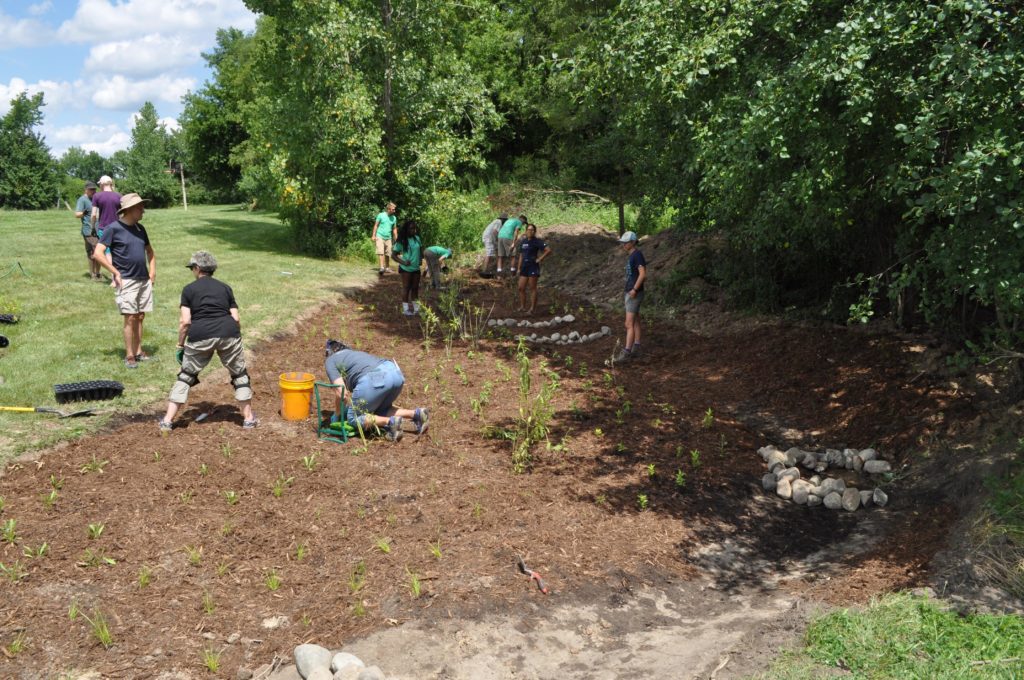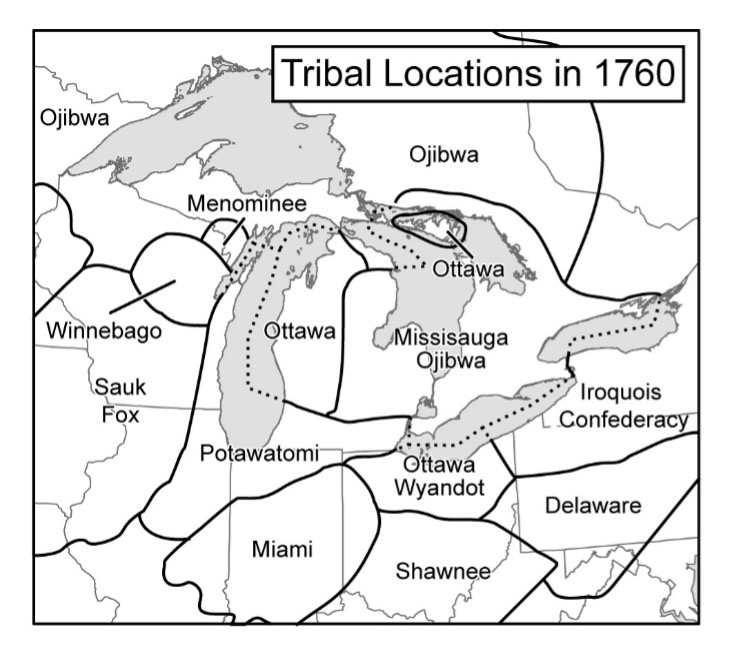Throughout the ages, people have sought out places in nature for solitude, contemplation, and assurance. Amidst the challenges nature faces today, such as climate change, we may wonder how much longer nature will be able to offer us these spiritual functions. May the refugia stories we offer along this trail be for you a source of hope and peace. You are welcome to linger here with us as a fellow sojourner on this trail.
As you walk this nature trail, look for the numbered posts. These will point you to additional narratives about the features along the way. The narratives will blend ecological insights with stories from history, with wisdom from Christian scriptures, and with faith practices that inform our daily life. They will teach you about the different elements of our refugia network and provide things for you to ponder and reflect upon. The narratives will be updated periodically.
Trail Post 1. As you begin your journey, quiet your thoughts and awaken your senses, preparing yourself to be attentive and patient. Consider how people have always sought out places in nature for solitude, contemplation, and assurance. Recall, too, the importance of pilgrimage in scripture, the way the people of God often find themselves on journeys, sometimes unsure of their destination. Creatures also engage in movement through their migration patterns or in response to environmental stresses. Along our journeys, humans and other creatures share the need for shelter, rest, and nourishment.
Here our trail winds its way through a relatively wild habitat that serves as a refugium, a place where wild species can find refuge from surrounding disturbances. “Refugia” (plural of refugium) are important for conservation of native species (those that have lived in our region for centuries) in the face of threats like climate change, emerging diseases, and introduced pests. They are also places where species interact ecologically, adapt to environmental changes, and develop new inter-relationships that enable ecological resilience. Even introduced (exotic) species can participate in these interactions, causing ecosystems to evolve over time – just as they surely did when Native Americans first arrived here over 2000 years ago. Natural systems are never static, especially when humans live in them!
Trail Post 2. This shagbark hickory (Carya ovata) tree is one of the oldest on our property, perhaps dating back to the time when European settlers first arrived here 200 years ago. The nuts of this species were a staple food for Native Americans, who also used them to make a nut butter and used the bark for making a pain remedy. Native deer, squirrels, and chipmunks also enjoy the nuts. Lingering in the shade of this tree for a while, you might notice that the tree is appreciated by many different bird species, including some who use it as a nest site.
If you look through the brush towards the east, you will note that this shagbark hickory is located on the edge of a small wetland that provides soil moisture, which is crucial for this tree and its companion plant species. Sites like this can therefore function as “climate refugia.” Since we are located near the northern edge of this shagbark hickory’s native range, it is likely that this tree and its understory companions in this refugium will be somewhat resilient against climate change. In the coming decades, as conditions become hotter and drier in the southern United States and cause suitable habitat to shift northward, this tree will likely be “welcoming” additional climate refugees. In a similar way, the Church of the Servant provides a Welcome Home that serves as a “refugium” for people who are experiencing a housing crisis.
Linger for a few moments beneath this magnificent shagbark hickory. Imagine the Tree of Life in the Genesis creation stories as well as the tree in Revelation whose “leaves are for the healing of the nations.” As you meditate and perhaps enjoy some solitude, consider the vastness of time from God’s perspective. Even this tree, so young in the universe, was alive long before you were born and will likely live far longer than you. Receive its gift of shade and shelter as gifts from God to you.
Trail Post 3. We call this area our “gratitude garden.” Many of the trees here were planted in honor of beloved members of our community who have died. We express our gratitude for their lives, but as we remember them, we also allow ourselves to feel the grief and sorrow that comes with deep loss. Our Christian faith invites us to face grief unafraid: we know our Savior is “acquainted with grief” and present with us by the Spirit, even in our darkest days. We are invited, too, to lament the destructive impacts we humans have brought about on this planet, feelings sometimes called “ecological grief.” We lament the loss of species diversity, the pollution we have unleashed on our air and water and soil.
Thanks to discoveries over the past couple decades, we can now say that trees also remind us of our interconnections to each another. On the surface, trees look to be distinct individuals. But underground, their roots are networked together with the help of fungi. These networks enable trees to share resources and to communicate with each other, helping them to withstand stresses in their environment.
Note that many of the trees on Church of the Servant’s campus are newly planted. Partnering with Plaster Creek Stewards, in 2021 we planted about ten different species of native trees – a total of 26 trees in all. You can learn more about the project by watching this YouTube video. Over the coming decades as these trees grow, they will attract native insects and birds by providing food, shelter, and breeding sites. In fact, in a recent book The Nature of Oaks, entomologist Douglas Tallamy describes how “oaks support more forms of life and more fascinating interactions than any other tree genus in North America.” Think that’s hyperbole? Read the book!
Trail Post 4. Both fire and gardens are important motifs in scripture. Fire can destroy but it can also purify. Sometimes fire indicates the inbreaking of God’s presence, as with the pillar of fire for the Israelites or the tongues of fire at Pentecost. Fires are also sources of warmth that draw people together. This, of course, is what we aim to do at this firepit, which was built during the COVID pandemic as a place where our youth groups could gather and enjoy each other’s company unmasked. Not surprisingly, other groups have also found their way here for casual conversations over a warm fire – and maybe a few smores.
Gardens figure prominently at key points in scripture: the Garden of Eden, of course, but also the garden in which Jesus’ resurrection took place and the garden city that Revelation depicts as the culmination of history. For us today, gardens are a place where natural processes and human will can interact productively and harmoniously. By planting with a focus on climate projections and key ecological functions, people can even engage in “refugia gardening” that helps local biodiversity adapt to new environmental conditions. Gardens, therefore, are places where we can witness God’s abundant provision, and through which we can imitate God’s creativity and generosity.
Trail Post 5. In 2015 Church of the Servant constructed a 20 kilowatt (kW) solar array and then expanded it in 2019 to the present 65 kW system. The present solar array produces about 1.2 megawatt-hours (MWh) of electricity in a cloudy winter month and over 8 MWh in a sunny summer month. Since 1 MWh is enough electricity to power an average US home for 1.2 months, the annual output of this system (about 65 MWh) is enough for about 6.5 homes. Most importantly, this solar array reduces demand for electricity produced by the burning of fossil fuels that release carbon dioxide (CO2, the most abundant greenhouse gas in the atmosphere) and other air pollutants (such as mercury). Our solar array dashboard tracks the total CO2 emissions our system has saved since 2015. The stats are quite impressive!
CO2 and other air pollutants pose serious human and environmental health risks. In fact, according to the World Health Organization air pollution globally affects 99% of us and kills about 7 million people each year, mostly (90%) in low- to middle-income countries. This disparity reveals an underlying injustice that grieves our conscience. Furthermore, CO2 levels in the atmosphere now exceed 400 parts per million (ppm), the highest in human history, and for the past decade have been rising at 2.4 ppm per year despite global efforts to reduce this rate. As a result, even if the nations of the Earth manage to meet their climate pledges, the global average temperature in 2100 is projected to reach 2.7°C (4.9°F) above the pre-industrial average. Such a world will experience ecological calamity of biblical proportions: floods, fires, megadroughts, extinctions, etc. – a morally unacceptable cost for our fossil fuel addiction!
Fighting climate change is therefore a matter of environmental and intergenerational justice. Church of the Servant sees this work as crucial to its mission, an expression of our love for God through the keeping of creation and through social justice.
Trail Post 6. Refugia provide relatively protected areas for pockets of biodiversity to survive and adapt during environmental disturbances. Biodiversity in the form of various interacting species enable ecosystems to survive in the face of disturbances. For example, the eruption of Mount Saint Helens in Washington state in 1980 produced a “moonscape” that looked like total desolation for hundreds of square miles. Yet after just a couple decades, scientists were surprised when the surrounding forests started growing back. The secret was later revealed: a high number of refugia with high biodiversity is what made the ecosystem more resilient (able to bounce back). Had there been fewer refugia or lower biodiversity, the ecosystem would more likely have undergone an ecological shift towards a less-productive state, perhaps becoming more like a desert than a forest.
The combined effects of climate change (which reduces organisms’ health and fitness) and declining populations of organisms (69% lower on average globally since 1970) has ecologists very worried. The two are likely to have a negative impact on the productivity of many different ecosystems around the world, some of which may experience a severe state shift commonly called a collapse. To counteract this, ecologists are scanning the globe to identify potential climate refugia where interacting species can perhaps adapt to the conditions of a warmer, less stable world. For this to succeed, wildlife corridors also need to connect from one refugium to the next. Such corridors are like the narrow, wooded area where you are currently walking. On each side are human dominated areas where environmental conditions are less hospitable to wildlife. Yet the corridor allows them to move between refugia, increasing the chance that they can avoid threats to survive another day. Thus, for wildlife conservation in a warmer world, these three are crucial: biodiversity, refugia, and corridors.
Trail Post 7. The area immediately in front of you is a lawn with a stormwater culvert. It is currently an area of mostly grass and weeds that tolerate polluted water from parking lot run-off. No doubt it was designed this way to reduce flooding risks, especially since the soil here is a heavy clay that does not allow much water infiltration. Grass was probably planted here because we have come to expect it as the default aesthetic: most people like the look of a green lawn. But from an ecological perspective, lawns are not very functional and way too costly. Grasses are wind-pollinated and so they offer no benefit for bees, butterflies, and birds. They offer very little food value for most wildlife other than some herbivores like rabbits and deer. Furthermore, turf grass requires frequent mowing which typically entails fossil-fueled lawn mowers and applications of chemical fertilizers and pesticides. None of these things are good for the environment.
While we plan to retain some grass around our building, we are imagining for this spot a better alternative: a rain garden filled with flood-tolerant flowering species with deep root systems. The deep roots are able to penetrate the hard clay soils, allowing rainwater to percolate through to the underlying groundwater. The root system also sustains the plants during periods of drought. In addition, many different species of birds, bees, and butterflies find the flowers of these plants utterly irresistible!
There are many native wildflower species with different shapes, sizes, and colors that are perfectly suited for such a rain garden. By planting several species together, such a garden would also have higher biodiversity that makes for a more resilient ecosystem. In his book Nature’s Best Hope, ecologist Douglas Tallamy outlines a strategy for converting lawn spaces into wildlife spaces all across North America. Tallamy also proposes linking such spaces in what he calls Homegrown National Park. If we can convert half our turf grass to native plants, we will have created a “national park” larger than our 13 current national parks combined!
That our refugium here at COS could be part of that system is quite an inspiring idea. But because such spaces typically look “more wild” and “untidy,” some people find them less aesthetically pleasing, especially in the fall after the flowers have turned into brown and grey stalks with “dead” seedheads. Nevertheless, at this stage the ecological functions of these plants continue: containing seeds for birds and over-wintering habitats for insects (some of which also serve as food for birds).
All of this causes us to ponder: What is true beauty? We are concerned with spiritual formation in our Christian communities, but are we concerned with aesthetic formation, with teaching people what we should consider beautiful? What would it take to shift our aesthetic assumptions so that we can consider a wild place beautiful, even as part of our church landscaping?
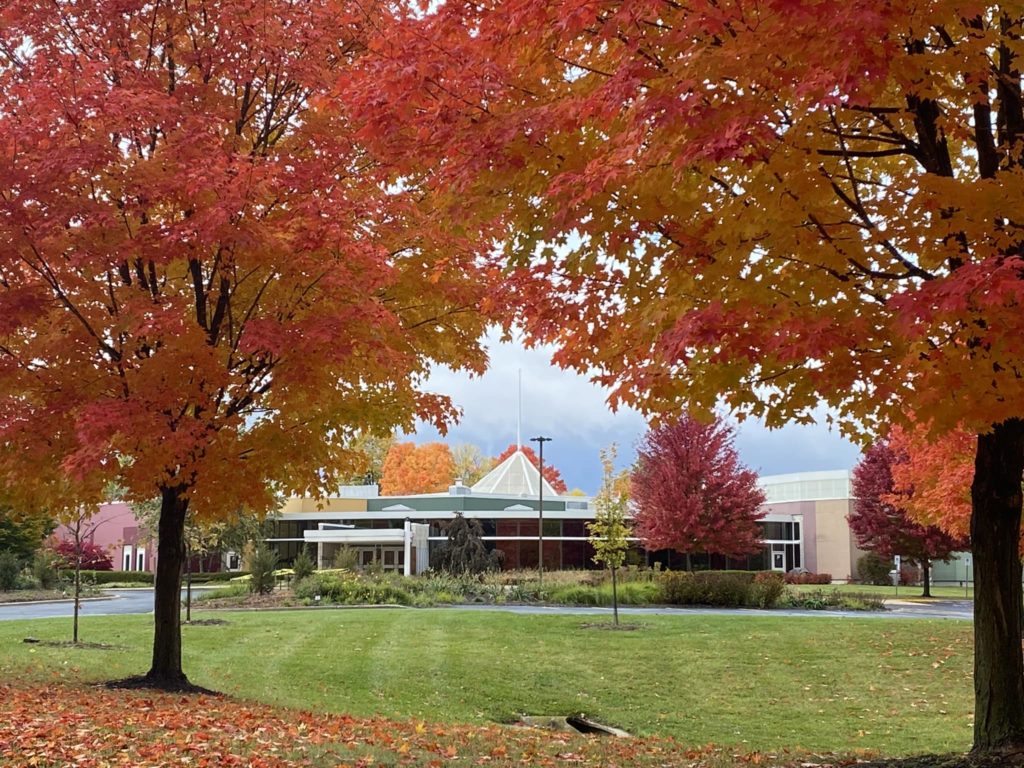
Trail Post 8. It is quite uncommon for nature trails to pass intentionally through parking lots. This one does for a couple of reasons. First, we want to draw your attention to the human-dominated landscape of the parking lot, all centering around the automobile. In fact, when you think about it, Grand Rapids and every US city are heavily comprised of automobile-dominated landscapes. The US has over 4 million miles of roads and about 30,000 square miles of pavement – enough to cover about 1/3 of the state of Michigan. While making it more convenient to drive cars, all this pavement confers serious environmental costs. It contributes to flash-flooding in urban areas, to pollution of streams and lakes with run-off water, to excessive urban heating due to unshaded parking lots and roads, and to decreased vegetation resulting from lower water infiltration into the soil. This is one of the many reasons why this is increasingly called the Anthropocene epoch (anthropos is Greek for human), dominated by humanity’s negative environmental impacts.
The second reason to draw your attention to this parking lot is to note the “islands” which are now planted with native species. In the summers of 2021 and 2022, numerous volunteers from Church of the Servant worked with Plaster Creek Stewards (a local restoration ecology group) to identify and plant suitable native species that could tolerate the harsh environment in the middle of a parking lot. We planted purple coneflower, rattlesnake master, prairie dropseed, stiff goldenrod, fox sedge, nodding wild onion, whorled milkweed, hairy beardtongue, black-eyed susan, beebalm, false blue indigo, tall blazing star, June grass, and plains oval sedge – a rich playground and smorgasbord for native insects and birds! Along the driveway leading to the front door of the church, we planted ten red cedars, a deer-resistant native species that will form a “processional” line, reminiscent of some liturgical dances that grace the different seasons of worship at Church of the Servant.
As you walk across this area, consider the extent of our human dominance on this planet. Christians have long contributed to “anthropocentrism”—the idea that humans are the most important creatures in the universe and the measure of all things. In its worst forms, anthropocentrism curdles into a sense that nothing else matters and humans can do whatever they wish to benefit ourselves. Many Christians today are among those who are warning that our anthropocentrism has reached outrageous proportions. We need to de-center ourselves and remember that we are part of a whole web of creation, all of which God declared “very good” and continues to love and sustain.
Trail Post 9. The low area in front of you is a drainage basin that collects stormwater from about half of the parking lots on this property. Especially in the spring, when the overflow drain to the storm sewer is clogged with ice, this area can quickly flood and form a large pond of standing water.
In 2019 with the help of Plaster Creek Stewards, we planted a bioswale in this basin. A bioswale is basically a very large raingarden planted with native species. This bioswale was intended to provide a refugium for pollinators and habitat for native insects and birds. Unfortunately, the extreme swings from dry ground to deep flooding proved to be too much for many of the species. Only a few survive to this day. While this was disappointing, there is an important lesson here about refugia: they are areas of experimentation that can fail. In fact, failure is a rather frequent feature of refugia. Ours is not a complete failure, and so we can propagate the surviving plant species as we gradually enlarge this bioswale in the coming years. In 2021 this bioswale became an officially designated wildlife habitat as part of the National Wildlife Federation’s Sacred Grounds project at places of worship throughout the US. The Sacred Grounds project gives us hope that other faith communities also understand the importance of creation care as central to their mission. As the saying goes: “Religion cannot be so heavenly-minded as to be of no earthly good.” This world and this life matter to God and so it is fitting that they matter to us.
As you observe this area, reflect on the importance of water throughout scripture: think of the rivers and seas and lakes key to many narratives. Think of the waters of baptism. As we say in our baptismal liturgy: “Water cleanses, purifies, refreshes, and sustains. Jesus Christ is the living water.” Water is a central symbol of the faith because all life depends on it. Part of our work in caring for creation is caring for water—its health and movement.
Trail Post 10. The land you’ve just walked is a tiny part of the ancestral home of the Three Fires Confederacy: the Ojibwe, Odawa (Ottawa), and Potawatomi peoples. In the 1821Treaty of Chicago, leaders of these nations were forced to cede nearly all their land (about 4 million acres) so that the US government could make the land more enticing to “settlers” by removing native peoples. During the two-week negotiation process, Potawatomi Chief Metea gave a prophetic speech portraying the lament of his people: “Our country was given to us by the Great Spirit, who gave it to us to hunt upon, to make our cornfields upon, to live upon, and to make down our beds upon when we die. And he would never forgive us, should we bargain it away. When you first spoke to us for lands at St. Mary’s, we said we had a little, and agreed to sell you a piece of it [in an 1816 treaty]; but we told you we could spare no more. Now you ask us again. You are never satisfied! We have sold you a great tract of land already; but it is not enough! We sold it to you for the benefit of your children, to farm and to live upon. We have now but little left.” Just a few years later, additional treaties resulted in more land dispossession, culminating in the treaty of 1833 which resulted in the Potawatomi being marched in a 660-mile “Trail of Death” from their last remaining homeland in northern Indiana to a small reservation in present-day Kansas.
Today in Michigan, the Ojibwe, Odawa, and Potawatomi retain possession of only a few small reservations. Nevertheless, the beauty of all this land still reflects their love and hope. As the modern-day beneficiaries of their legacy, we would do well to acknowledge this land as a temporary gift from the Creator to be shared with all our kin (human and other species) who now make it their home.
The ancient laws of Israel established the principle that land, too, needs Sabbath rest. What would it mean to receive the gifts of this land as part of our Sabbath rest from our human busyness, but also to return that gift, offering this land rest from our human needs and disturbances, and especially from our human injustices. This is the redemptive vision of God for all creation, a vision we desire to live into through our witness as we care for this land.
May God grant us the wisdom and love to live into the future with hope and true satisfaction.
